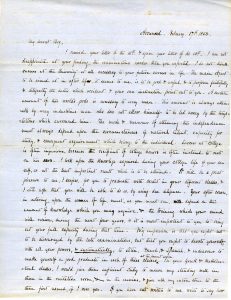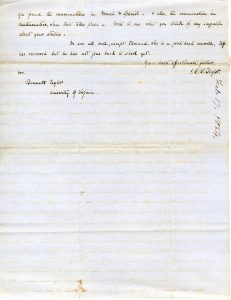This post was contributed by Seonyoo Min, Rare Book Cataloging Intern at the Small Special Collections Library.
The Guanhailou Collection is a collection of East Asian rare books formed by Soren Edgren, Editorial Director of the Chinese Rare Book Project at Princeton University and current RBS Instructor. Recently, part of the collection was transferred to the Albert and Shirley Small Special Collections Library. As a Summer 2022 intern at the UVA Library who has a background in East Asian Book History, I was able to get a chance to catalog and process 338 titles of invaluable rare materials, written in Classical Chinese, Modern Chinese, Japanese, Korean, Tibetan, etc. Cataloging records I created this during my Summer 2022 internship will help you to find books from Guanhailou more easily, and help you understand the overall information of the collection quickly.
The Special Collection Library manages diverse materials written in various languages besides English. Catalogers in there always consider the best way to introduce these collections to the community. Through this blog post, I would like to share with you all the new things I learned during my internship.
How do you find a book you are looking for? In my case, I use a library catalog. I visit a library website, and search for a title of the book, or search keywords that I want to explore. And then, I look at a list of catalog records to find a book I want to investigate. In particular, in the case of Special Collections, the place with “closed stacks,” catalog used to be the only medium that made books accessible to me. Sometimes, even if I do not look for books to read, I look at a library catalog when I want to get some information about on books or writers. And then, I use hyperlinks on the list to search for books on related topics or books written by the same author.
Library catalogs can help you when you find books, when you want to get brief book information, or when you need well-organized information about the book you are looking for. In libraries, staff called ‘Cataloger’ makes catalog records every day to connect valuable information to library users who want to use it. Special Collections Library also has wonderful catalogers.
Catalog records of special collections are a bit more special than usual library catalog records that we are familiar with. Most of the materials in Special Collections are old, and they often go through the hands of several owners before they come to the library. Therefore, you can find descriptions about previous owners or history of the material itself: such as notes written by owners, purchase receipts, and photographs in the bookcase. In addition, catalogers sometimes need to catalog materials other than books, such as leaflets, scrolls, sculptures, etc. The charm of the special collections catalog comes from explaining contextual information and some special physical formats. It helps library users to efficiently search for information by allowing them to understand the characteristics of the materials, without physically looking at them.
Guanhailou Collection
Guanhailou (觀海樓) Collection was formed by Dr. James Sören Edgren (or 艾思仁, 1942-), former Editorial Director of the Chinese Rare Books Project at Princeton University. The primary focus of the collection is Chinese rare books, but the collection also includes significant rare materials in East Asian book history outside China, and some sample leaves of early printing in Europe. Overall, the collection gives a chronological overview of the East Asian book history and printing history, spanning the period of the 12thcentury to the 21st century.
Here are some collection highlights of Guanhailou Collection.
Guanhailou A144
十竹齋箋譜 (Shi zhu zhai jian pu), edited by Hu Zhengyan (1584-1674), Beijing: Rong bao zhai, 1934. 1 volume.
Guanhailou A144 is a Chinese stationery paper book. This 1934 copy is a reprint of xylographic polychrome stationery from Ten Bamboo Studio (十竹齋), Ming Dynasty. Every page of the book contains beautiful printing with detailed light and shade. You can also figure out Chinese blind printing technique (拱花, gong hua) through this book. It is a similar concept to blind embossing of Western culture.
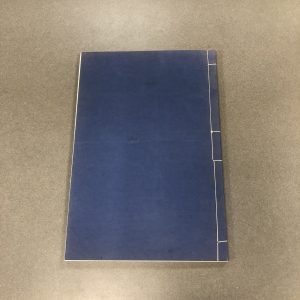
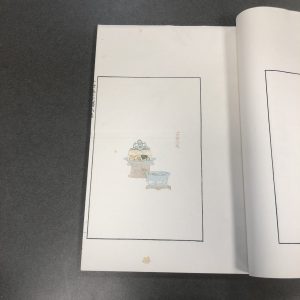

At the backside, 2 pieces of correspondence are laid in the book (Photo 3). The document on the right side of Photograph 3 is the correspondence from R. J. Walsh (1886-1960) to J. Walter Flynn (1910-1977), regarding the book itself and their plan for a new article. The document indicates that the Guanhailou A144 is a presentation copy (no. 12 of 21) by Zheng Zhenduo (鄭振鐸, 1898-1958) to Nym Wales (Helen Foster Snow, 1907-1997).
Guanhailou A144 not only shows an advanced printing technique of China, but also shows the intellectual communication between China and America in 1930s, regarding Chinese publication history. I am thinking about finding a corresponding article in the ASIA journal in the upcoming days, to satisfy my curiosity.
Guanhailou A175
妙法蓮花經卷第三 (Myōhōrengekyō kan dai-3), [Japan], 12th century. 1 roll.
Guanhailou A175 is a Lotus Sūtra (Saddharmapuṇḍarīkasūtra) manuscript, used gold and silver pigment on indigo paper. When you open the scroll, you can find a frontispiece illustration depicting the three chapters of the Lotus sūtra, chapter 5 to 7. I enjoyed finding out which part of the illustration represents each chapter. If this material is used in undergraduate classes or graduate school’s introductory Buddhist studies class, I think it will be a meaningful experience to compare the texts and illustration of the sūtra.

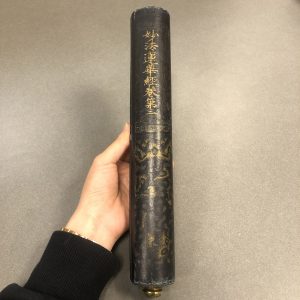

Lotus Sūtra is my favorite Buddhist text, because of the idea of equity in chapter 5, Parable of the Plants, which is in the first part of the Guanhailou A175. In this chapter, Sakyamuni likens the people to plants. Every plant has various heights and leaves size. These differences make each plant’s acceptable amounts of rainwater (wisdom) different. In Sakyamuni’s view, every person has a possibility to become a buddha, so they are equal. He thought if he understood each person and gave them a customized sermon for them, everyone could get enlightenment. This phrase was helpful to me at the time when I just started teaching as a graduate assistant. Thanks to the phrase, I could try to understand each student’s characteristics and their interest more. I hope this sūtra will help someone who is starting a new career in dealing with people.
Guanhailou A095
中說 (Chungsŏl), written by Wang Tong (584-617); annotated by Ruan Yi, [Seoul: Kyosŏgwan], [not before 1484]. 1 volume.
Guanhailou A095 is a canonical work of famous Confucian scholar Wang Tong (王通). Wang’s insights into Confucianism, education, and politics are well described in conversations between Wang and their students.
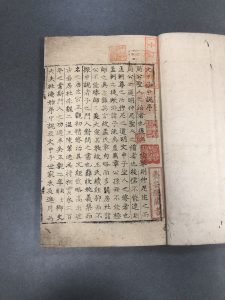
A number of Ex libris stamps on the caption title page, and photographs and documents laid in shows the solid provenance information, from the 16th century to the present.

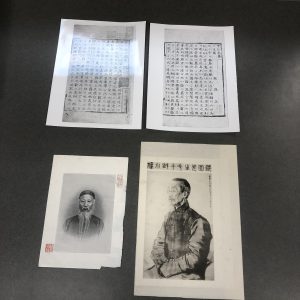
What makes this book so attractive is the printing style and provenance. This metal movable type printing used Korean metal movable type called Kapchinja (甲辰字). Made by palace in 1484, this movable type is well-known for beauty and its small font size. It was used until just before the Japanese invasions of Korea (1592-1598).
After the war, the book started a long journey outside Korea. A number of Ex libris stamps on the caption title page, and photographs and documents laid in shows the solid provenance information, from the 16th century to the present.
Guanhailou A095 is a wonderful teaching and research resource to study history of Japanese book collectors and the wartime history of East Asia. If there is anyone who is interested in the history of Korea-Japan relationship, they will fall in love with this book.
Cataloging Guanhailou Collection
Making catalogs of the 338 titles of rare books, I realized that this collection has invaluable content and contextual information, showing the long history of intellectual distribution and exchange. I cannot deny that this collection is attractive, but I thought it is quite difficult to access because most of the materials in the collection were written in Chinese characters. As a cataloger, I need to focus on creating catalog records with accurate metadata according to the guidelines. But this ‘language barrier’ made me think more about how to effectively share this information with entire UVA communities. This thought brought out in me the memories when I just started to study East Asian book history.
I was a junior in college, and was learning about East Asian history, but bad at reading Chinese characters. When I first took a glance at East Asian rare book catalog records, I was embarrassed because there was nothing I could read. At that time, I thought it would be wonderful if I could know the topic of the book at least. Also, I wanted to read the Ex Libris seals on the first page of the main text. I simply thought if I knew the previous owners of books, I could more easily figure out the theme and value of the book. However, understanding those decorative engraving seal scripts was impossible for the student who had just begun to memorize regular script Chinese characters.
While cataloging the Guanhailou Collection, I wanted to make a catalog that people like me in the past could read and would like to read. As mentioned earlier, catalog is a search tool that allows library users to find information efficiently. I was convinced that if I could create a catalog that even users who did not know Chinese characters could figure out the title, author, subject, and provenance information of the book, I could reduce the time of information research for users and help users’ decision-making. Let me talk a bit more about subject information and provenance information.
Catalog records of Guanhailou A095, “中設.”

Catalog records of Guanhailou A095, “中設.”
Most catalog records in Virgo use controlled vocabulary called Library of Congress Subject Headings (LCSH). Developed and maintained by the Library of Congress, this thesaurus is one of the most well-known and widely used controlled vocabulary in the library world. Catalogers find or combine the appropriate words in this huge wordbook to describe topics well. If you know LCSH, you can not only understand the topic of the book you are looking for, but also figure out the list of books with the same subject. Catalog records of Guanhailou Collection also contain LCSH. If you click the blue hyperlink at Subject field in Image 10, you can see multiple UVA Library materials with the topic. “Philosophy, Confucian – Early works to 1800.”
Provenance information, information about where the book comes from is in the Local Notes field. As you can see the Image 10, there is a string of the previous owner’s name that can be found in the book. If you know those people and could find a relationship between their interests and the book, you may discover some knowledge that has not been known before.

A Screen you can see when you click “Full Metadata” hyperlink
Currently, the processing for Guanhailou Collection is almost complete. If you search for “Guanhailou” in Virgo, you can explore its catalog records managed by the Special Collections Library. If you want to learn more about the book, please click the “Full metadata” at the bottom of the record, and “FULL RECORD” button. You can read additional information of the material written in some Chinese characters, such as physical description, table of contents, and more subject information.
Finding Your Books
Library resources in foreign languages always makes library users think one step back. They are much harder to find, and even if we find something, it takes more time to figure out if this information is necessary for research. Catalog records of Guanhailou Collection might not give you a complete answer but would assist your decision making at least. I hope my records could help you on your journey to explore our amazing East Asian rare book collection and find some new things that will make you excited.


